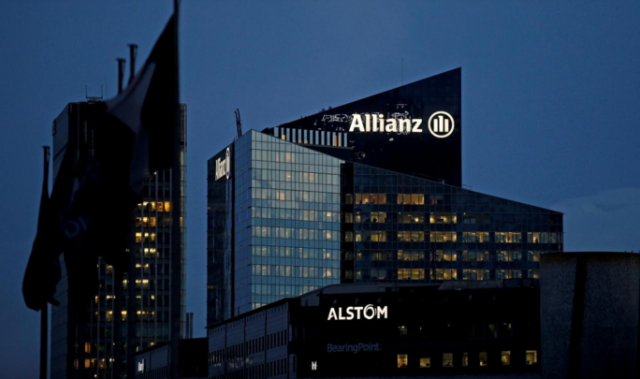
HONG KONG – After ports and industrial parks, the dealmakers leading China’s trillion-dollar push to build a modern Silk Road are turning to the financial sector, targeting Europe’s banks, insurers and asset managers to tap funds and expertise.
Last week, sources familiar with the matter said two of China’s most acquisitive conglomerates, HNA Group and Anbang Insurance Group, had separately considered bidding for the German insurer Allianz SE.
Neither of the two made an offer, but the talks marked a new level of ambition for China: Allianz is a German stalwart, a pillar for local pensions and a global powerhouse with 1.9 trillion euros ($2.3 trillion) of assets under management.
HNA already owns a stake of just under 10 percent in Deutsche Bank.
Bankers, lawyers and company executives say more financial deals will come, led by state behemoths such as China Life and China Everbright, as well as private firms including Legend Holdings and China Minsheng Financial.
“The message from the regulators is clear – they want these companies to go out and get access to large amount of funds and expertise,” said a financial M&A adviser at a global bank, who works with Chinese regulators and companies.
“They would look very favorably at transactions that have some links to the Belt and Road program, because the country needs to boost its financial muscle,” the banker said. But Beijing “will ensure the excesses of the past couple of years do not happen again.”
The banker, who declined to be named as he was not allowed to speak to the media, said his firm was currently working on several “mid-sized to large” foreign financial takeover deals.
After a deal spree that saw Chinese conglomerates spend billions on everything from landmark property to soccer clubs in a debt-fuelled M&A drive over the past two years, Beijing has sought to rein in some of the excesses.
But Belt and Road deals have been an exception in the crackdown this year – including, most recently, financial deals.China’s outbound M&A volume targeting financials has reached nearly $9 billion as of last week this year, not far from $12 billion in all of 2016, according to Thomson Reuters data. If exceeded, it would be the second best year for such deals since at least the global financial crisis in 2008.
The share of financial transactions in overall outbound deal volume has also risen to 8.2 percent this year, higher than 5.7 percent in the same period last year, while industrial deals, typically the biggest sector for outbound M&A, fell by a third.
EXPANDING FOOTPRINT
Earlier this month, Legend – the top shareholder in the computer maker Lenovo – agreed to buy a 90 percent stake in Banque Internationale a Luxembourg (BIL) for $1.8 billion.
The deal, Legend said, was linked to the Belt and Road initiative, President Xi Jinping’s policy of building a modern Silk Road to expand global trade and influence.
“Our overseas investments will continue to focus on the opportunities that are provided by the Belt and Road national policy,” the company said, in a statement to Reuters, adding it would “actively invest” in other areas of financial services, including insurance, securities and financial technology.
It gave no details, but bankers said Legend has been eyeing banks and insurers in Southeast Asia, Europe and Hong Kong, using its healthy balance sheet and the halo effect of Belt and Road-linked initiatives.
Better financial expertise and depth will help China secure contract guarantees, financing and better insurance.
“We need those overseas financing institutions – buying them can expand our bank assets and boost foreign firms’ participation in our projects abroad,” said Huo Jianguo, vice-chairman of the China Society for WTO Studies, under the Ministry of Commerce.
“China is having a hard time attracting international institutions to get involved” in Belt and Road projects, Huo said. “If that persists it will become an one-man show, which is not sustainable.”
Besides Legend, others eyeing the sector include the insurer China Life, China Minsheng Financial, China Everbright Ltd,part of the state-owned China Everbright Group, and Haitong International Securities.
They are mainly scouting for investment and acquisition targets in Europe and Asia, said bankers and lawyers.
WATCHDOGS
Chinese companies will not be expanding into the financial services sector at will, of course. Acquisitions of stakes in foreign banks – never mind full ownership – are already closely monitored by overseas regulators.
But while banks may be tough targets, bankers and executives say Chinese institutions and conglomerates could instead target asset management, insurance or wealth managers.
China Everbright plans to allocate $1.5 billion of its 2017 spending to the purchase of a fund manager, private bank or insurer overseas to help it raise cash more easily and extend its presence abroad.
China Merchants Bank has been “actively looking” for wealth management firms in Europe, said one person familiar with the matter, adding that not all financial acquisitions in the near term may have clear Belt and Road links.
China Minsheng Financial declined to comment on its plans, while Haitong International said it does not “have any plans at the moment”. China Life, Legend and China Merchants Bank did not respond to requests for comment.
“Finance is definitely an encouraged sector under the recent Chinese outbound investment guideline,” said Christina Lee, a partner at the law firm Baker McKenzie’s capital markets practice in Hong Kong.
“PRC financial institutions are mostly domestically focused,” Lee said. “M&A is a fast way to gain exposure and expertise in the international finance scene.”









